Finding perfect and approximate square roots of integer or decimal numbers step by step
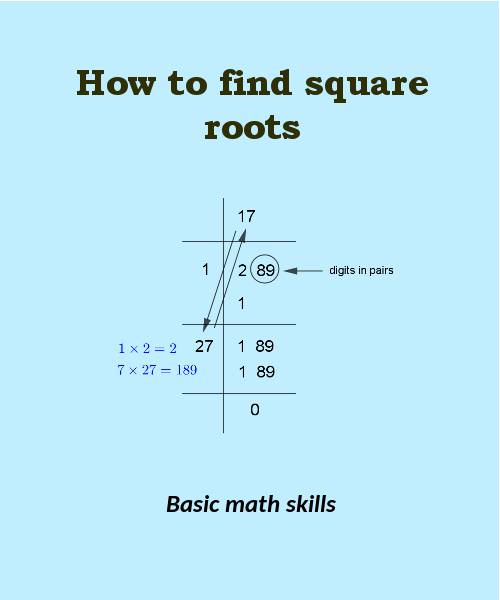
For most needs of finding square root, if we remember by heart squares and cubes of a few common integers, using quick factorization we can figure out the square roots or cube roots of numbers be it an integer or a decimal. But occasionally, in a few specific types of arithmetic problems, there is no other option than to actually evaluate the square root of a number following a method specifically tailored for the purpose.
To meet this specific need, we will explain in this session a method for finding out perfect or approximate square root of integers as well as decimal numbers.
We will show the method using varieties of example numbers to highlight variations in the method. We will also explain why the method works. If you understand this "why" part, your belief and hence ease of memorization and application of the method will get better.
We will end the session with a set of exercise problems with answers.
Method to find square roots of numbers
Square root of integer numbers
Problem example 1. Number of digits of the integer odd: Find the square root of 289.
Refer to the figure below while going through the steps.
Step 1: Write 289 in pairs of digits starting from least significant digit on the right. 89 will be the first pair and 2 will remain to be a single digit.
Step 2: Find the integer part of square root of the leftmost pair of digits or the leftmost single digit. In this case, square root of 1 will yield 1. This will be the most significant digit of the resultant square root. Write it at the top. Let's call it current digit.
Step 3: Write the square of the current digit below the most significant digit and find difference of the two which is 1 here. Bring down the next pair of digits on the right, that is, 89 to append to the difference 1. The number formed is then 189. Let's call this new number. This completes the first stage of finding the most significant digit of the square root.
Step 4: On the left of the new number write the double of square root result formed till this stage. At this point it will be just, $1\times{2}=2$. We need to find a digit to append to 2 so that product of this two digit number formed and the digit appended is just less than or equal to the new number 189. Appending 7 to 2 will form 27 and 7 times 27 is 189 with remainder 0. The digit 7 is now the current digit and it is appended to the square root result at the top to form 17 as the final square root. The method stops when remainder is 0.
Following figure shows the steps of the method.
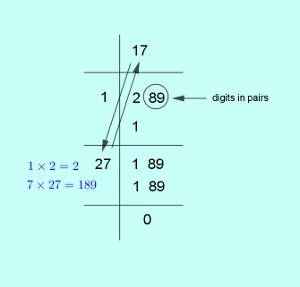
Problem example 2: Number of digits of the integer even: Find the square root of 7921.
Step 1: 7921 is written in pairs of digits from the right as, 79 21. 79 is now the most significant pair of digits.
Step 2: Integer part of square root of 79 is 8 and its square is 64. Difference between 79 and 64 is 15 which becomes 15 21 when appended by the next pair of digits brought down from the number being in focus. 8 is the current digit and forms the most significant digit of the square root result.
Step 3: Square root result formed till now 8 is doubled to 16. We find appending 9 to 16 will form the new number as 169, so that $9\times{169}=1521$. 9 is appended to 8 to form the square root result as 89. Remainder being zero, 89 is the final square root.
Following is the figure representing the steps.

In this second example we have dealt with a proper pair of most significant digits instead of a single most significant digit as in the first example. But both the square roots in the two examples are two digit numbers. In the third example we will go one step higher to deal with a three digit square root.
Problem example 3: Square root of a six digit integer: Find the square root of 588289.
First step: The number in the form of paired digits is written as 58 82 89 with 58 as the most significant digit pair.
Second step: Integer part of square root of 58 is 7, its square 49 and difference between 58 and 49 is 9. After appending 82 brought down, new number becomes 982.
Third step: Square root till now 7 is doubled to 14 and 6 is appended for the product $6\times{146}=876$ to be just less than 982 by 106. Appending the next pair of digits 89 makes the new number 10689, while the square root result becomes 76 by appending 6 to the already obtained most significant digit 7.
Fourth step: Square root till now 76 is doubled to 152 and appending it with digit 7 makes $7\times{1527}=10689$ with remainder 0. So 767 is the final square root.
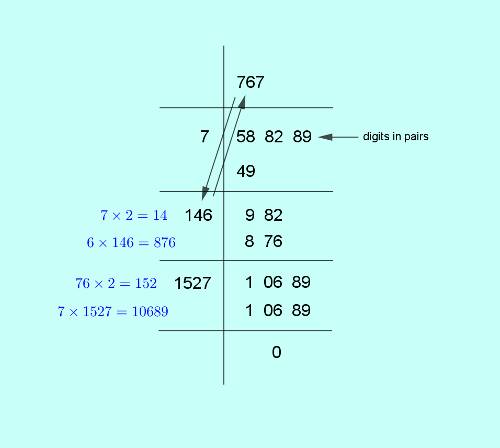
If you practice on a few small and large numbers, the method should become very easy to carry out even for large numbers.
Square root of decimal numbers
Problem example 4. Even number of decimal digits: Find the square root of 62.2521.
Just remove the decimal by taking out the factor, $10^{-4}$ square root of which will be, $10^{-2}$. After finding the square root of the integer 622521, multiply the result by $10^{-2}$. This course of action can always be followed.
Nevertheless we will show the operation to find the square root of 62.2521 directly as below.
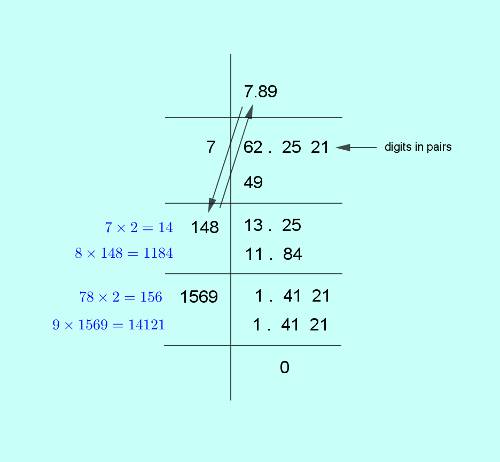
We will now end this session with two examples on how to find a square root approximate to say, 2 or 3 digits. Approximation is needed when remainder doesn't become 0 early.
Approximate square root of a number
Problem example 5: Approximate square root of an integer: Find the square root of 5579 approximate up to second decimal digit.
As such there is no basic difference between the methods for exact integer square root and approximate square root. In the exact integer square root, the remainder become zero and there is no decimal in the square root. In contrast in some cases, after exhausting the integer digit pairs we would find a remainder still exists and so we will start dropping down pairs of 0s to append and form the new number. From this point on, the digits of the square root result would cross over the decimal point and form the decimal part.
The following figure should clarify.
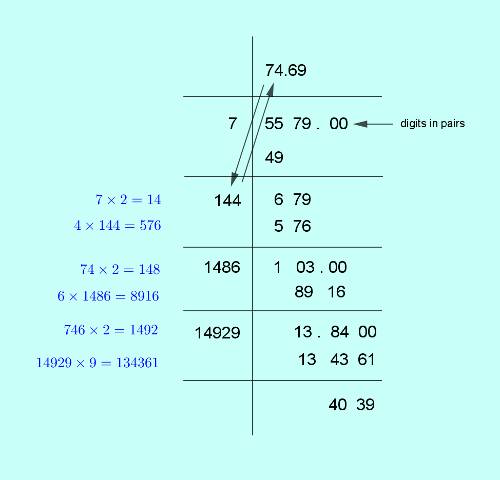
Answer is: 74.69.
Strictly speaking, for accuracy up to second decimal digit, we need to evaluate the third decimal and check for rounding off.
We will take up another example of decimal number with odd number of decimal digits approximate up to 3 decimals.
Problem example 6: Approximate Square root of a decimal number with odd number of decimal digits: Find the square root of 21.521 up to 3 decimals.
With even number of decimal digits, it is possible to have a perfect square root with zero remainder, but when the number of decimal digits is odd, there is no chance of having a perfect square root.
The main doubt that arises in finding such a square root—how do we form the paired digit form of the number? Just append a 0 on the right and number of decimal digits will be even so that paired digit formation would pose no problem.
The steps in finding the square root of 21.521 is shown in the following figure.
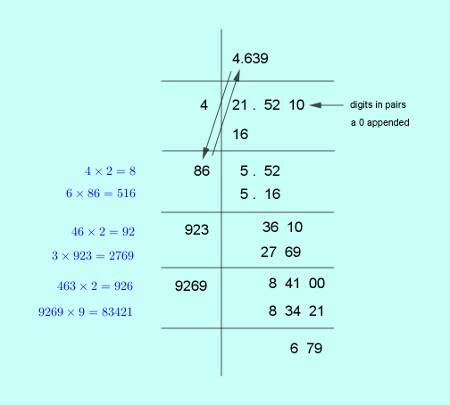
If you are curious, you may go through the last section to get a feel of why this method works as it is intended to work.
Why the method of square root works
Primarily the method of square root is based on the relation,
$(a+b)^2=a^2 +2ab+b^2$, where $a$ and $b$ are two parts of the target square root and the parts are broken up on the basis of place value mechanism.
We will show how this happens using the process of finding out the square root 673 of the integer 452929.
The following figure shows the application of the method on 452929 to find its square root 673 unerringly.
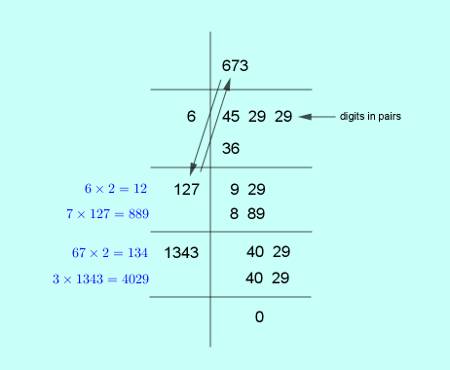
Finding the first and most significant digit of the square root is relatively easy to understand. Consider,
$452929 = 450000+2929$.
At the first step we found $6^2=36 \lt 45$, but $7^2=49 \gt 45$ and so we put 6 as the most significant digit of the square root. Here 45 was the most significant digit pair of number being operated upon.
Effectively, the digit pair 45 represented 450000 of the number being operated on, and digit 6 represented 600 of the square root being found out. $600^2=360000$ is less than 450000 but $700^2=490000$ would have been more than 452929 without any doubt. This is why, when we don't know anything about the lesser significant digits of the square root, we could still find the most significant digit with assurance and no confusion.
Assume that we already know the square root as 673 and will verify its square as 452929, it is other way round approach.
Using number breakup and square of sum relation on 673, we may express its square as,
$(600+73)^2=(600)^2 +2\times(600)\times{73} +73^2$
$=360000+1200\times{73}+73^2$
Note that after identifying 6 as the first digit of the square root, we have subtracted $6^2=36$ from the most significant digit pair 45. Effectively, we reduced 452929 by 360000, so that 92929 remained as residue.
By the expanded square of sum relation then,
$92929=1200\times{73}+73^2$
$=73\times{1273}$
Breaking up these two factors in a different way we get,
$92929=(70+3)(1270+3)$
$=70\times{1270}+3\times{1340}+3^2$.
The 12 of 127 comes because of doubling 600 in the expansion above. In the same line of analysis, when we subtracted, $7\times{127}=889$ from $929$ effectively we reduced 92929 by 88900 resulting in a remainder of 4029. So,
$4029=3\times{1340}+3^2=3\times{1343}$.
Compare this step with the last step of our above method and identify formation of 134 first as double of 67, the square root formed till then, and then 1343, with 3 as the third digit of the square root to fully compensate the remaining portion of the original number.
Exercise questions with answers
Exercise Problem 1. Find the square root of 529. Answer: 23.
Exercise Problem 2. Find the square root of 6241. Answer: 79.
Exercise Problem 3. Find the square root of 9409. Answer: 97.
Exercise Problem 4. Find the square root of 17161. Answer: 131.
Exercise Problem 5. Find the square root of 522729. Answer: 723.
Exercise Problem 6. Find the square root of 3829849. Answer: 1957.
Exercise Problem 7. Find the square root of 1.585083 approximate to 3 digits. Answer: 1.259.
Exercise Problem 8. Find the square root of 297.666009. Answer: 17.253.
Exercise Problem 9. Find the square root of 10.58311505. Answer: 3.25317.
Exercise Problem 10. Find the square root of 175.1474111 approximate to 6 digits. Answer: 13.234327.
